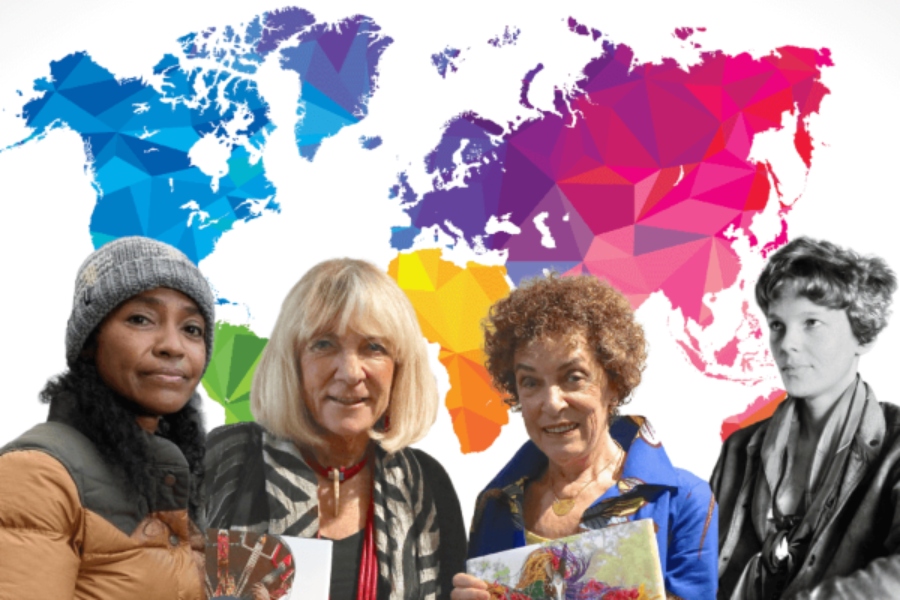You probably recognize the name Gail Collins. Throughout her career, she has been watching, reporting on and writing about the forces that shape women’s lives. She became part of the New York Times staff in 1995 as a member of the esteemed editorial board, and is well-known for her role as an Op-Ed columnist. When she was appointed editorial-page editor in 2001, it marked the first time a woman held that title. She also holds the distinction of receiving a hostile note from Donald Trump, after writing a column in 1992 about The Art of the Deal.
As the author of numerous books about women in society, Collins now brings readers up to date on how the female sex has navigated aging in America. No Stopping Us Now: The Adventures of Older Women in American History is an intriguing compendium of prose and fascinating factoids. Chapters range from “The Colonies” to “Into the Twenty-First Century.” The final chapter “Onward and Upward” profiles top icons Ruth Bader Ginsburg, Hillary Rodham Clinton, and Nancy Pelosi.
Combining deeply researched findings (even about menopause during the Civil War) with the acerbic wit that Collins utilizes in her columns, it’s a lively ride. The reader meets plenty of characters with guts and determination, most who have previously been relegated to the dustbin of history.
Why This Topic Now?
What got Collins off on this journey? In a recent TV interview, Collins said, “I lived through the period when everything changed in Western civilization for women. It was transformation forever. And I got to see it all.”
But the actual impetus came when previous book research unearthed a letter from an early American colonist. He was seeking a wife in England, who would join him in the new world. Unlike today’s dating requisites, his parameters were broad: “Civil and under 50 years of age.”
Collins decided to delve in and learn more about women’s lives in America over the past 200-plus years. During the birth of the country and during periods of expansion, as long as women were creating wealth by delivering goods and services, they were valued. Churning butter, spinning yarn, making candles, raising children — they had plenty to contribute, according to Collins’ research.
Once populations shifted and became more urban, however, things changed. Women were relegated to the functions of either marriage prospect or child-bearer. For “middle-class” women, once the kids were grown, that didn’t leave a lot of options. In fact, as Collins found, “the role of mother was the only show in town.” It had a limited shelf life as well. Collins notes, “And once the last child was gone, they [women] were literally put into a corner —the one with a rocking chair.”
Racism in America’s Roots
As she researched, Collins was struck by the role discrimination played in the lives of women. She makes a point to examine how the struggles of African-American women differed and definitively diverged from the path of those who were white throughout various time frames. She doesn’t hesitate to call out Susan B. Anthony and Elizabeth Cady Stanton as being “undeniably racist,” a reality that is more widely recognized now. They were furious that “well-educated white women” were not getting suffrage, while men who were “ignorant negroes and foreigners” were allowed to cast their votes.
One activity both white and black women engaged in during the 1800s was a steady presence on the lecture circuit (the entertainment mode of the day). The goal was to proselytize and inform audiences about their concerns. Abolition was the key issue that engaged most women on talking tours. Black women, specifically Sojourner Truth, had been speaking publicly long before the Civil War, calling widely for the end of slavery.
In the mid-1800s, Cady Stanton had success being accepted as a speaker because she understood the need to pull the “Grandmother” card. Unlike Anthony, she had seven children and could sidestep the “old maid” category. She embraced her coiffed gray hair and corpulent figure, and dressed fashionably. When confronted by male audience members who objected to females being active outside the home, she responded, “The same woman may have a different sphere at different times.”
Read More: My Book Club, My Self: How Novels and a Group of Readers Got Me Through 25 Years
The Swinging Pendulum
Throughout the narrative, Collins delivers a mash-up of information on fashion, career options, women’s purchasing power, age discrimination stats, and shout-outs to women from all walks of life. Her findings reflect a rapidly swinging pendulum, where every upside has a downside.
Examples abound that share the ups and downs of daily life for our foremothers.
- Teaching became a way to escape the “useful maiden aunt role.” Collins explains that with the rise of public schools, “administrators realized that women were better able to handle the children…and cheaper. Much cheaper.” Women ended up making less than an unskilled male laborer.
- In the mid-19th century, doctors and health experts advocated a move away from constricting corsets and the 37 pounds of clothing women wore during the winter. However, the 1920’s outfits which liberated young women who adopted flapper fashions made those 19-year-old female consumers a preoccupation with marketers, thereby launching America’s youth obsession.
- Job prospects ebbed and flowed. In 1928, a 35-year-old stenographer related she couldn’t get a foot in the door because the age cut-off was 25. During World War II, Rosie the Riveter had her day, and women of all ages had a vital role in the war effort. However, by the 1960s, airline flight attendants had mandatory retirement rules that kicked in when they got married or aged out at 35. (They took it to court.)
Will You Love This Book?
If you are interested in learning more about the history of American women, through information leavened with humor, Collin’s approach will be your cup of tea.
I learned that Barbara Armstrong, the first woman law professor in America, was the “architect of the Social Security program.” I also got new insights into the depth of Margaret Chase Smith’s character. She was the first woman elected to the Senate who was not the daughter or wife of a man who had previously held the seat. She supported the civil rights movement, the ERA, and had the nerve to speak up against Joseph McCarthy, delivering her “Declaration of Conscience” speech.
Collins lays out her motivation for undertaking the project in her Introduction. She writes:
“Imagining the future is easier if we look back on where we’ve been so far. Whether it’s a 77-year-old midwife riding out in the middle of the night to help a patient in 1800 or an 80-year-old riveter making planes during World War II or an 86-year-old justice getting in shape for another Supreme Court session, the heroines are the women who fight back age by living for something more than just survival.”
In 2030, 1 in 4 women will be 65 or older. Attitudes will continue to shift. If nothing else, the numbers will be on our side.























0 Comments